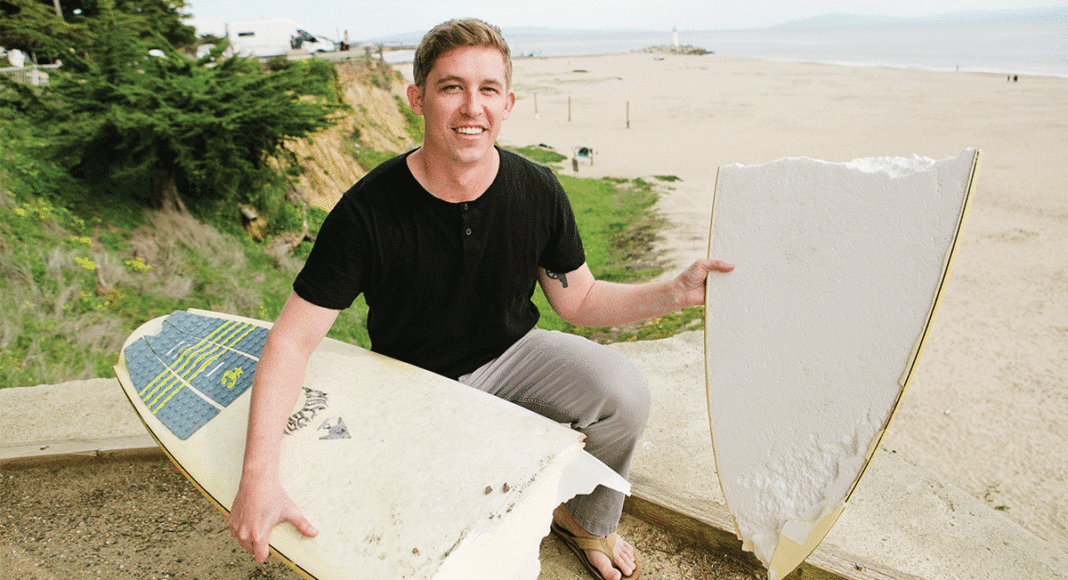[dropcap]I[/dropcap]n the remake of The Graduate that will surely never be made, the movie’s most famous line is ripe for rewrite. In the original film, when a well-meaning older man puts his arms around young Dustin Hoffman’s shoulder to offer some unsolicited career advice, he says “I just want to say one word to you: Plastics!”
In the contemporary updating, one word wouldn’t be enough.
“I just want to say four words to you: Sustainable alternatives to plastics!”
If the salvation of humanity depends simply on the stuff we use (and then throw away), then the next planetary superhero is likely to be a materials engineer like John Felts, CEO of the start-up Cruz Foam, who will be honored as Innovator of the Year at the 2018 NEXTies at the Rio Theatre on Friday.
Felts and his business partners/co-founders—UCSC engineering prof Marco Rolandi and fellow engineer Xiaolin Zhang—have put a distinctly Santa Cruz stamp on their effort to save the world: They’re working to create a new kind of surfboard, and in the process develop a sustainable substitute for polyurethane foam.
Polyurethane foam is everywhere in the contemporary world—in buildings, cars, shoes, furniture, bedding, medical devices, packing material and, indeed, surfboards. It is a synthetic polymer related to traditional plastics, and the manufacture, use and disposal of polyurethane foam causes significant environmental hazards. It is an uncomfortable irony for many surfers that their daily communing with Mother Ocean is only made possible by a giant slab of polyurethane foam covered in polyester resins. Surfboard shapers, who make the “blanks” from which surfboards are manufactured, are particularly aware of the toxic nature of these materials.
Enter Cruz Foam, with a novel idea to tackle this dilemma. Felts and his partners are looking to create an alternative to polyurethane foam through a material called chitin, a natural substance found in the exoskeletons of shellfish such as crab, lobster and shrimp.
Chitin, Felts says, is cheap, widely available, durable and without many of the hazards associated with polyurethane and polystyrene, more commonly known as styrofoam.
“It’s a material that back in the 1970s and ’80s was promised as this super-material that was going to solve the world’s problems,” says Felts in his office on Santa Cruz’s Westside. “But people found out pretty quickly that it wasn’t easy to process. It can be processed, but under extremely harsh conditions with some really nasty chemicals.”
Felts says his company has developed an eco-friendly, water-based process to turn chitin into an industrial foam. Once the prototype surfboard is ready, he and his partners can get it in the hands of local surfers who will test it out in Santa Cruz’s surf breaks.
“Somebody will ride it, and they can tell us, ‘y’know, it was a little heavy, or it dragged here a bit, or didn’t feel right in the flex.’ Then we can take it back, do a little tweaking and get it back out there for more testing,” he explains.
Despite its drawbacks, polyurethane foam has many desirable qualities for surfboard manufacturing. It’s durable, affordable, dense, lightweight and “shapeable,” all of which sets a high standard for any material aiming to replace it.
“Shapers really want a different material,” says Felts. “Many have said to us, ‘Please, I would love to have a different product.’ But when it comes down to it, you have to meet or beat what they’re used to. As much as they might like the idea of something, if it’s going to diminish or lessen the product they’re making, they’re not going to use it.”
Felts says that he is shooting to bring a product to market by the end of the year, at which point he hopes to explore potential partnerships with surfboard manufacturers. If all goes well on the surfing front, Cruz Foam may move into other realms where polyurethane foam is now the standard.
“As the tech becomes more refined, you have to look at how the economies of scale come into play. We have to be able to compete [on price],” he says. “That’s one of the reasons we’re starting with surfboards. Typically, they are a high-margin product, compared to, say, packing peanuts, which are so so cheap.”
Throughout it all, Cruz Foam will have to work to get the message out about its raw material. The chitin that the company plans to use for its surfboard blanks comes largely from seafood shell waste, which is a cheap by-product produced in fisheries and manufacturing plants in southeast Asia, among other places.
To be clear, “we are not grinding up shrimp to make surfboards,” says Felts with a laugh. “It’s an off-white powder. You’d never know it came from a shrimp if you held it in your hand. And no, for the record, we don’t think it’s going to attract sharks, or anything like that. Hey, it’s a fair question. And we have to test it, obviously. And it’s not going to have that nasty shrimp smell. That would be a hard sell. It’ll be nothing like that.”
For more information on John Felts and Cruz Foam, go to cruzfoam.com.














